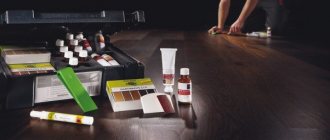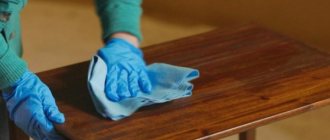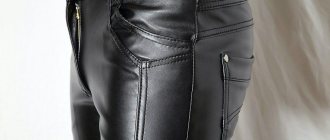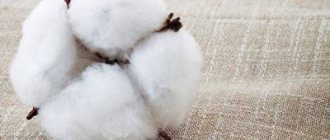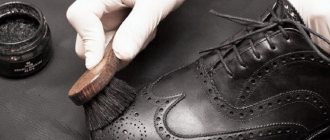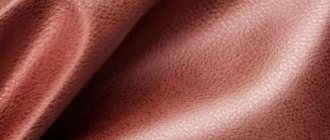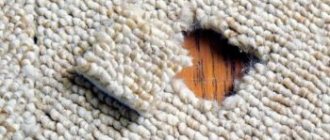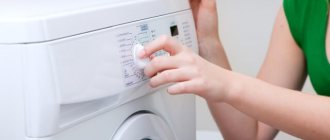Furniture made from eco-leather has excellent characteristics and costs much less than a similar option made from genuine leather.
During operation, abrasions, cracks, stains and snags may occur, which sooner or later will lead to the formation of bald spots and holes requiring expensive repairs.
If you think the only way to prevent this is to use protective covers. Then what is the point of spending money on such furniture, the beauty of which will always be hidden under the mask of bedspreads?
There are other ways to care for eco-leather furniture that will preserve its original appearance after many years of daily use.
A few important rules
Before buying eco-leather furniture, first of all think about practicality. The purchase will not be beneficial if:
- There are animals in the house that like to sharpen their claws on the end of the wooden frame.
- There are small children who love to draw with felt-tip pens.
- There is a lot of traffic in the room during the day.
All this will lead to the fact that the furniture will be constantly exposed to negative influences and will quickly lose its attractive appearance. Therefore, if you have a sofa or chairs made of this material in your home, remember a few important rules:
- Any dirt must be removed immediately using a soft damp cloth or rag - eco-leather is difficult to clean from old dirt, as the surface can easily be damaged, leaving scratches.
- Furniture needs daily preventive cleaning - small debris accumulates in the joints and depressions, which will stick to clothes in a couple of days.
- If the stain is old and dried, then you need to apply a damp soft cloth to it for 2-3 hours, waiting until it softens and moves away from the surface on its own without applying force.
- It is better to install eco-leather furniture away from radiators and radiators, since they dry out the air, which will cause cracking of the coating if it is not treated with special moisturizing mixtures.
- If there are animals in the house, then they should be weaned from sharpening their claws on the sofa. There are special products that emit an unpleasant odor, scaring the animal away from the furniture.
- Before using a cleaning product, be sure to check whether it is suitable for eco-leather. Typically, the furniture manufacturer gives recommendations regarding care, indicating specific brands of detergents and cleaning products.
By following these rules, eco-leather furniture will last for many years, and it will look the same as after purchase.
How to properly care for leatherette furniture?
A blanket can protect furniture from stains and mechanical damage. But even this method does not completely guarantee that the fittings will retain their original appearance for a long time. Therefore, if the sofa is made of fabric or eco-leather, it still needs proper and constant care.
When cleaning the house, it is recommended to wipe the furniture with a soft, clean and damp cloth. You can clean hard-to-reach places on folds using a vacuum cleaner. To avoid damaging the material, you should use a special attachment.
Regardless of whether the sofa is white or colored, the paint may change its shade (white may turn yellow). For this reason, it is recommended to install furniture so that it is not exposed to direct sunlight. You can prevent eco-leather from drying out if you place the sofa away from the heater.
To ensure that the upholstery lasts a long time, it is recommended to treat it with special sprays or creams at least 2 times a year. When purchasing furniture, you should immediately ask the seller what leatherette care product the manufacturer recommends using.
How not to clean?
It’s paradoxical, but even the highest quality material can be ruined due to ignorance. To prevent this from happening, pay attention to the following points:
- Do not use hard brushes to remove difficult stains. Abrasives will scratch the surface, which will later create a hole.
- Avoid using gasoline, solvents and other aggressive compounds that can leave burn marks.
- Do not use hot air from a hair dryer for drying. It deforms eco-leather and makes it vulnerable at the slightest tension.
- Coarse cleaning powders, as well as salt and soda, scratch it upon contact with the surface, so you should also avoid using them in cleaning.
- It is strictly forbidden to use bleach and other chlorine-containing products, as they destroy the structure of eco-leather and bleach the color. In addition, the material is capable of accumulating an unpleasant and pungent odor that lasts for several days.
- Acetone and products containing it cannot be used to remove any types of stains.
Some “traditional craftsmen” advise using alcohol if there are persistent stains. This should not be done, since alcohol in its pure form can leave a burn at the site of application, which will soon cause the formation of cracks and holes.
Safe products and tools
Leatherette and eco-leather are popular because of their practicality. This coating is washable and does not require complex maintenance. Most stains can be easily removed with soap, but some stains will require a little more effort.
- Food stains - greasy marks, chocolate - are washed off with dish gel marked “Anti-grease” or laundry soap.
- Stains from berries and grass should be bleached after washing with citric acid or hydrogen peroxide.
- The blood is immediately washed off with cold water, and a cotton pad with ammonia is placed on old stains. Then scrub, adding ammonia as needed.
- Nail polish, acrylic paint, brilliant paint are washed off with nail polish remover.
- Chewing gum and plasticine are first carefully wiped off with a gauze swab, and the residue is removed with alcohol.
- Gouache and watercolor can be washed with liquid soap and a melamine sponge.
- Oil paint can be wiped off with turpentine.
White eco-leather is easy to clean with a melamine sponge
You can clean a white leatherette sofa with a soft melamine sponge, cotton rags, dry and wet wipes. Excessive force should not be applied so as not to damage the capricious material.
Mechanical tools and brushes with hard bristles should not be used. They can scratch the surface, which will have a much worse effect on the appearance of the upholstery than the stain you are trying to remove.
Special preparations for the care of leather and faux leather products are best suited. They can be purchased at household chemical departments, car service centers, leather and shoe stores.
All products differ in release form:
- liquid solutions;
- aerosols;
- foam;
- impregnated napkins;
- pastes;
- gels.
Detergents should not contain chlorine or aggressive chemical compounds. Typically, store-bought preparations contain isopropyl alcohol, ammonia or ammonia in varying concentrations. You can safely use LOC liquid bleach from Amway, Bagi “Super Leather”, Flat, Pufas “Glutoclean”, Unicum and others.
If you are unwilling or unable to purchase a special composition for caring for leather products, you can make the necessary product yourself. Home remedies treat stains in different ways. It depends on the age and type of contamination.
What compositions can be used for a leatherette sofa:
- A soap solution made from laundry or baby soap will help wash away fresh dirt.
- An alcohol solution (from 20 to 50%) will cope with pen stains and greasy areas.
- Lemon juice or vinegar, diluted in half with water, will remove stubborn dust and dirt. After washing, be sure to wipe off the acid with a damp cloth.
- A weak solution of ammonia (no more than 5%) is good for removing old stains.
- Hydrogen peroxide from your home medicine cabinet will help remove various stains.
- Shaving foam refreshes the surface well.
You need to moisten a cotton pad or sponge with any homemade composition and apply it to the stain. Then rinse off any remaining detergent with clean water and wipe the upholstery dry. Finally, treat the material with a silicone sponge to restore its shine.
Daily care
It is recommended to clean furniture once a day. No special detergents are needed for this.
You can do this in two ways:
- Dry cleaning with a sofa vacuum cleaner - be sure to use a soft attachment on the vacuum cleaner that will not scratch the surface. Cleaning will help remove all the dust and dirt, as well as crumbs and small dirt.
- Wet cleaning - a soft rag is moistened in warm water, completely wrung out and passed over the surface of the furniture. First, dirt is removed from the folds, after which the entire surface is wiped.
There is no need to apply any products, nor do you need to dry it. The furniture will dry on its own in 1 hour.
There are special microfiber cloths that have long pile and remove dirt well without having a negative impact on eco-leather.
How to clean eco-leather covers
During use, car seat covers are regularly exposed to dust, dirt, sunlight, temperature changes and much more. Special products for cleaning eco-leather are mainly used in dry cleaning of car interiors. The choice of products is not as large as other groups of household chemicals, but it is there.
List of funds
The most common ones are listed below:
- Pufas Glutoclean artificial leather cleaner;
- Turtle Interior Dry Cleaners;
- Runway upholstery cleaners;
- Fill In interior cleaner;
- universal detergent Vineet.
Features of cleaning
Regular wet cleaning of the interior will eliminate excessive rubbing of the covers. But car covers are rarely stain-free.
Wet wipes for cars are an indispensable driver's assistant.
Stains that wet wipes cannot remove can most likely be removed with a melamine sponge and soapy water. To avoid streaks, it is important not to let the cover get wet for a long time; the surface must be quickly removed from soap with a clean damp cloth and wiped with a dry one.
Car cosmetics make the use of covers more comfortable and durable. Automotive stores offer special care products and water-repellent impregnations.
What to pay attention to so as not to spoil the covers by cleaning them yourself
Cleaning eco-leather covers yourself is easy. We choose the most gentle means: melamine sponge, laundry soap solution, alcohol solutions, hydrogen peroxide. You can purchase a special interior cleaner.
The main thing when cleaning eco-leather covers is to quickly and thoroughly wipe them from moisture, without tugging. At the end of the cleaning procedure, the covers must be dried at room temperature, without additional heat exposure (hair dryer, heater, heating, etc.)
If cleaning the interior yourself does not give a satisfactory result, you can take the car to a professional dry cleaner. A rich arsenal of tools and the experience of specialists almost always cope with contamination.
Attention!
Using aggressive products (hairspray, toothpaste, 70% alcohol solution (perfume), nail polish and nail polish remover) to clean the salon is dangerous and highly undesirable. These products should only be used as a last resort and may damage the covers. Taking into account the risk, as well as the mobility of transport, dry cleaning services seem to be more rational.
Eco-leather is an artificial material very similar to natural leather, widely used for making clothes, bags, and shoes. It is used to make car covers and furniture upholstery. In appearance, artificial leather cannot be distinguished from natural leather, but there is a slight difference in the care of the products.
In order for eco-leather products to have a beautiful appearance and serve us for a long time, we need to properly care for them. Regular and proper care is one of the elements of strength and durability. Each type of pollution has its own cleaning method and we must know them in order to avoid unnecessary problems.
Furniture
- Do not place it near heating appliances or in direct sunlight. When exposed to strong heat, the upholstery becomes deformed and fades in the sun;
- remove dust with a cloth or napkin slightly moistened with water;
- in case of heavy contamination, wipe with soapy water;
- Remove greasy stains with a solution of ethyl alcohol and shaving paste;
- remove ink stains with acetone, then wipe with a damp cloth;
- if the skin is white, then wipe it with warm milk;
- We remove stains from grease and oils on white skin using hydrogen peroxide.
Important
! When caring for eco-leather, you need to use weak solutions (20%) and wipe the product dry after processing.
Shoes
- Wipe regularly with a damp cloth; if heavily soiled, use a special shampoo;
- do not allow moisture to get inside the shoes;
- use moisture-resistant protective creams;
- In case of severe scuffs, touch up with shoe paint.
Reference
! All natural leather care products can be used for eco-leather.
Cloth
- can be washed in warm water using liquid laundry detergent;
- do not expose to strong mechanical stress;
- After washing, let the water drain; do not wring out;
- dry on hangers of suitable size to avoid deformation of the products;
- some things can be washed in automatic machines by choosing a gentle mode without spinning;
- For minor stains, wipe with a cloth slightly moistened with water, a solution of detergent, or an alcohol solution.
Note
! To avoid damaging your clothes when washing, follow the instructions on the manufacturer's label.
Car covers
- Can be cleaned in the same way as any eco-leather product. Wipe with a damp cloth, alcohol solution, acetone, hydrogen peroxide; after treatment, wipe with a dry cloth.
- There are many car seat care products on sale in the form of foams and creams, use them. Apply the cream to the surface, let it absorb a little and then wipe with a cloth.
- After cleaning, treat the surface with water and a dirt-repellent agent.
- Very dirty covers should be dry cleaned.
To care for and clean leather products, you can use cleaning wet wipes for monitors. They contain alcohol, they clean well, dry quickly and do not harm artificial leather.
Fighting stains
No matter how carefully you care for your furniture, stains will appear sooner or later.
Greasy and corrosive, they spoil the appearance of any, even the most expensive furniture, and the removal of each of them has its own characteristics.
Oily stains
The faster the fat is removed from the surface of the eco-leather sofa, the easier it will be to remove the stain.
The sequence of actions is as follows:
- Quickly remove excess grease with a dry cloth without pressing on its surface, as the stain will penetrate deeper into the coating faster. Change the napkins until they no longer absorb grease particles.
- Take a drop of dish detergent, apply evenly to the stain, and leave for 3-4 minutes.
- Use a damp soft cloth to remove any remaining detergent in a circular motion.
- Let it dry.
If you are unable to remove the stain the first time, you can try this method several more times. The contamination will become noticeably lighter, after which it will be completely unnoticeable.
In the event that a greasy stain was created a long time ago, but was not noticed immediately, the following improvised means will help:
- Ammonia and warm water - take 1 tablespoon of ammonia per glass of warm water, dilute it, blot a rag and apply it to the stain. Press down lightly and hold for 3-5 minutes.
- Hydrogen peroxide – take a cotton pad, soak it well in peroxide and place it on the stain. Cover with a rag and place a light weight (book, overturned chair). After 5 minutes, remove the cotton pad and let the stain dry.
- Shaving foam - apply a thick layer of foam, leave for 5 minutes, then remove any remaining residue. There is no need to wash it off.
If all this does not give the desired result, then you can buy a special stain remover for eco-leather furniture. The instructions will indicate how and in what cases to use it.
Contamination from markers and pens
Traces from a ballpoint pen are among the most difficult types of stains to remove, which hopelessly stain eco-leather furniture. It is not always possible to completely remove contamination, and old stains will remain in place forever.
If this type of contamination occurs, you can try the following methods:
- Hair fixing varnish - spray varnish onto the ink stain, wait 2-3 minutes, remove the residue with a cotton pad. Repeat until all dirt is gone.
- Slaked soda works well with markers and felt-tip pens. Extinguish a tablespoon of baking soda with a tablespoon of apple cider vinegar, apply the paste to the stain, and after a minute wipe off the residue.
- Nail polish remover - lightly wet a cotton pad and clean it with gentle, gentle movements in the direction of the stain.
- Glass cleaner - apply to the stain, let sit for 5 minutes, then use gentle blotting movements to remove any remaining dirt.
The faster the action was taken, the greater the chance of completely getting rid of the ink and felt-tip pen stain.
Wine and juice stains
If an alcoholic drink, juice or compote gets on the surface of light-colored furniture, there is every chance that a colored stain will remain. It’s not easy to fight it, but you can try the following methods:
- Liquid soap and citric acid - dissolve ¼ teaspoon of citric acid in 50 ml of water, add a tablespoon of any liquid soap. Apply the resulting mixture to the stain and gently wipe it off with gentle movements.
- Dishwashing detergent and ammonia - take 1 drop of ammonia for 1 tablespoon of dishwashing detergent, apply to the stain, let stand for 10 minutes, then remove the excess.
Spilled drinks must be removed from the surface as quickly as possible before they are absorbed by the coating. The older and deeper the stain, the more difficult it is to deal with.
Daily care
Seats, sofa armrests, and bags made of white material become greasy over time and acquire a yellow tint. Denim clothing leaves bluish or gray stains on the seat. How to wash eco-leather from everyday dirt?
For this you will need:
- laundry soap;
- dishwashing liquid;
- wet wipes for caring for leather items;
- citric acid solution or lemon juice to whiten the surface;
- automotive leather cleaning products;
- melamine sponge eraser.
When choosing a car product for eco-leather, you will have to experiment - not all of them cope with dirty deposits in the same way; sometimes using laundry soap is easier and more effective.
Citric acid or hydrogen peroxide provide good whitening. The second, moreover, kills bacteria, which is useful for animal owners.
Disinfection
Any surfaces in the house need periodic disinfection, which will help reduce the concentration of pathogenic microorganisms. And the eco-leather sofa is no exception. The following means can be used for this purpose.
| Name | Frequency | Sequencing |
| Baby liquid soap | 1 time per month | Dissolve a teaspoon of soap in a glass of warm water until it foams. Moisten a soft cloth in soapy water, twist it well and walk over the entire surface. The cloth should be rinsed periodically in soapy water. |
| Water with lemon juice | Once every 2-3 months | For 1 liter of warm water you need to take 3 tablespoons of lemon juice. First, you should treat the armrests and headrests where there are visible areas of grease. Next, use a damp cloth to go over the remaining areas. |
| Water with ammonia | Once every 6 months as a preventive measure | You need to dissolve 4 tablespoons of ammonia in 1 liter of warm water, moisten a soft rag and walk over the entire sofa. If there are stains, you can linger on them and treat them several times |
| Special antibacterial wipes for leather furniture | Daily or as needed | Take the napkin out of the pack, unfold it and apply it to the recommended area. If there is a lot of furniture, then you need to use more than one napkin, but change them as they become dirty. |
Disinfection should be carried out as soon as it gets dirty. If the furniture is rarely used, then once a month is enough. With high traffic, treatment is needed daily.
How to properly wash a white sofa made of eco-leather or leatherette
White eco-leather needs to be washed with special products and a soft cloth.
The practicality and availability of leatherette allows you to buy a beautiful sofa model at several times cheaper. But such upholstery is finicky to care for. If you do not take into account some of the nuances of handling such materials, you can easily damage the furniture.
How to wash a surface made of eco-leather or leatherette:
- Do not get the upholstery too wet; if possible, use dry cleaning. Spilled liquid must be blotted up immediately, otherwise the skin may become deformed.
- Fresh stains should be wiped with a soft sponge and a foamy solution of laundry or baby soap. The sooner the treatment is carried out, the higher the chances of removing the mark completely.
- To remove stubborn stains, use non-aggressive detergents. If performance is low, switch to stronger formulations.
- Do not use too hot water or ice, as eco-leather does not tolerate thermal effects well.
After using any cleaning products, be sure to rinse off the chemicals, then wipe the upholstery with a clean rag, which will absorb any remaining moisture.
You need to dry a white eco-leather sofa naturally. You cannot use improvised tools: hair dryer, iron, heater - this will hopelessly ruin the upholstery.
The best care products
Manufacturers of high-quality eco-leather furniture insist that owners use only specially developed products that do not harm the coating, remove dirt well and protect the surface from cracking. The best of them are the following:
- Eco mist is a spray that does not require rinsing. It removes dirt well, is non-toxic, completely safe for children and pets. Gives furniture shine and gloss. Does not contain fragrances and is safe for allergy sufferers and asthmatics.
- Glutoclean – removes dirt and debris well and has an antistatic effect. Does not cause allergic reactions, protects leatherette from the negative effects of ultraviolet radiation and dry air.
- Unicum – gently cleanses and nourishes eco-leather, gives a beautiful, moderate shine. Does not require rinsing or wearing gloves.
Before using products, make sure that they are specifically approved for use on non-natural leather surfaces. Read the instructions first, as each of them has its own method of application, and some need to be rinsed off.
What products should not be used when caring for eco-leather?
Eco-leather requires delicate handling, and in order not to cause irreparable harm to the material, you should take into account a number of prohibitions.
When cleaning eco-leather products, the following is unacceptable:
- use brushes, even with soft bristles;
- use powders containing abrasive particles and bleaching components;
- clean eco-leather with compounds containing chlorine and acids;
- remove stains from the surface of the material using bleaches and solvents;
- treat the material with products intended for other types of fabrics.
In addition, when drying eco-leather products in the fresh air, they should be placed under a canopy; in the sun, the material can become deformed and burn out.
Items made from eco-leather and other synthetic materials require careful care. Depending on the type of contamination, different cleaning agents are allowed.
The following can be dangerous for any product made from eco-leather or leatherette:
- excess moisture;
- exposure to high temperatures;
- cleaning with a steam generator;
- abrasives.
Chemical solvents should be used with caution. Some of them can damage the surface.
You cannot use powdered soda, brushes or hard sponges - they will leave scratches, dirt will penetrate deeper, and it will be impossible to get rid of them. If the surface is glossy, dull spots will remain on it after cleaning with abrasive agents.
General tips and tricks
Caring for eco-leather furniture, although not easy, is worth it. The coating will have an attractive appearance that cannot be distinguished from real leather.
Follow these guidelines:
- Do not cut off the dirt with a sharp object - this may lead to the formation of a hole.
- Aggressive chemicals, even in small quantities, are prohibited.
- It is better not to use a hairdryer and ice cubes - temperature changes will lead to damage to the integrity of the canvas.
- If a stain appears, you need to remove it as quickly as possible before it gets stuck.
Expert opinion
Kokovin Dmitry Vasilievich
Furniture restorer
Furniture made from eco-leather in light colors is more whimsical, since over time it can darken and fade, and any dirt is clearly visible. Think before you make a purchase and evaluate its feasibility specifically for your home.
Traces from pens and felt-tip pens
If there are children at home, the question of removing traces of their art sooner or later arises in every mother. Fortunately, modern felt-tip pens can be easily washed off with water, but the same cannot be said about ballpoint pens and markers.
Ballpoint pen ink is the most difficult stain to remove. They must be removed as quickly as possible so that the dye does not become embedded in the coating. If the ink is not dry, there is a chance to wash it with soap and a melamine sponge. After drying, you can whiten the surface stained with a pen in several ways.
- Method 1. Nail polish remover. Cleans off fresh ink, markers, and gel pens.
- Method 2. Hairspray. Apply, wait a couple of minutes, wipe off with a cotton pad, repeat if necessary.
- Method 3. Leather polish and solvent for polyurethane glue. First, treat the surface with polish or conditioner to protect it, wait 5 minutes, and then wipe the stain with a solvent. When used correctly, this treatment removes even old hand marks without harming the leatherette.
Methods using slaked soda, alcohols, and citric acid will remove the ink of gel pens and water-alcohol-based markers. Since ballpoint pen paste has a wax-fat composition, these methods will be ineffective for it.
General recommendations
There are special wet wipes that are designed for everyday care of leather and leatherette items. They are designed to remove dust and minor dirt. Try using them first if the stain is fresh. If success is not achieved, read the recommendations below.
Dried stains do not need to be scraped off when cleaning leatherette products. Also, do not use detergents with solvents containing petroleum products. Strong acids and alkalis should also be avoided. Therefore, dishwashing and plumbing detergents will not work for you. Dampen the old stain with a neutral soap solution.
- It is easier to remove fresh stains than old ones;
- Do not rub the artificial leather surface excessively;
- Avoid using abrasive cleaning products;
- systematically clean leatherette furniture;
- It’s easy to add shine to a product: silicone-impregnated sponges contribute to the formation of a protective film;
- Before treating the entire surface, test the selected products on a small area of skin that is out of sight;
- If there is an opportunity to resort to the help of specialists, it is worth taking advantage of it.
As you can see, the presented methods for cleaning leatherette are simple, and the variety of means adds confidence in the presence of one of them nearby when needed. When the opportunity arises to practically test their effectiveness, do not neglect the recommendations given by our specialists in order to avoid the opposite result!
We suggest you familiarize yourself with How to remove black stripes from shoes: home methods
All kinds of grease stains of organic origin do not pose a danger to leatherette: the stain is wiped with a dry cloth and left for a certain period.
How to clean white leatherette
